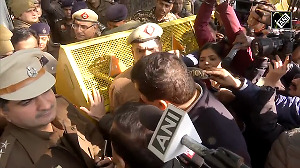Days after the Bombay High Court's approval for transfer of Dabhol assets, a senior NTPC official told PTI, "We will now start talks with Maharashtra State Distribution Company for finalising a PPA." Ratnagiri Gas and Power, in which NTPC, GAIL and lenders have 28.33 per cent equity each and MSEB has 15 per cent, is taking over the assets for about Rs 8,500 crore (Rs85 billion).
The newly-floated company would sell to MSEB 95 per cent of the electricity generated from the 2,184 mw plant, which is later planned to be scaled up to 4,000 mw after the completion of the second phase by November 2006.
The remaining five per cent of the power generated could either be sold to another state directly or through a trading company, the official said.
The PPA is likely to be signed in a month after which RGPPL would approach Central Electricity Regulatory Commission for approval of tariff, he added. RGPPL would offer power to MSEB at a fixed cost of Rs 0.96 per kilowatthour (unit), in addition to the variable cost that could be about Rs 1.60-1.70 per unit.
In other words, the bulk tariff would be in the range of Rs 2.50-2.70 depending upon the price of imported LNG.
Though the tariff was earlier estimated to be about Rs 2.30, the higher cost of Rs 2.70 would even now be less than half the price of Rs 7 at which erstwhile US energy trader Enron was selling power to Maharashtra.
Enron was charging between Rs 6-8 per unit while MSEB was paying less than Rs 3 to other states from where it was buying power in 2001.
The first 740 mw phase of Dabhol was generating power and the second 1,444 mw phase was nearing completion when MSEB terminated the contractual agreement with Enron over payment disputes. This led to shut down of the entire power plant in June 2001, resulting in messy legal battles between various stakeholders that ended only recently.
The power-starved state, which saw a public outcry over massive shortages of about 4,000 mw, has not added any generation capacity during the past decade.
With the Dabhol power plant coming into operation next year and that too at a competitive tariff of less than Rs 3, the power situation in Maharashtra is expected to get better by the end of next year.






 © 2025 Rediff.com -
© 2025 Rediff.com -